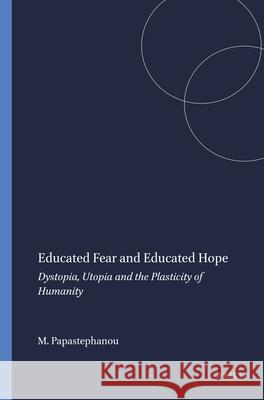Educated Fear and Educated Hope : Dystopia, Utopia and the Plasticity of Humanity » książka
Educated Fear and Educated Hope : Dystopia, Utopia and the Plasticity of Humanity
ISBN-13: 9789087909741 / Angielski / Miękka / 2009 / 220 str.
Beyond dominant tendencies to contrast utopia and ideology, the book reconceptualizes utopia and approaches it along with the notion of dystopia. The interplay of utopia and dystopia is examined, some major anti-utopian arguments are refuted and a new utopianism emerges, one that radicalizes critique and makes engagement with present global realities more pressing. Educated fear, i.e., a critical awareness of dystopian realities, and educated hope, i.e., a critical awareness of the possibility of human perfectibility cohabit a theoretical space that breaks with utopianist modern theoretical underpinnings and becomes historically and spatially more inclusive, while retaining the motivational and justificatory force of ethical imagery. If education is not just an institution of unreflective socialization, if it is about futurity, it has to renegotiate utopian thought. As the interest in utopia is being renewed both in general philosophy and philosophy of education and as dystopia is still neglected, a book that re-defines utopianism and explores for the first time the role of dystopia in radicalizing educational demands for systemic change is indispensable for Utopian Studies, Philosophy and Philosophy of Education academics and students alike. The title of the book is first transliterated into Utopia, a typeface in which Brazilian artists Angela Detanico and Rafael Lain replace capital letters with the iconic buildings of Brazils foremost modernist architect, Oscar Niemeyer, whilst lower-case letters are equated with urban interferences such as fences, skateboarders, CCTV cameras, electricity cables, in short, all those elements that escaped the utopian dream of the architect. To me, it bears associations of the philosophical notion of counterfactuality and of Adornos notion of mimesis. The title is then transliterated into Helvetica Concentrated (a digital typeface that concentrates the surface of Helvetica characters in dots which has been created by Detanico and Lain in collaboration with Jiri Skala). The term Helvetica bears the associations of a modernist utopia of success, performativity, prosperity, predictability, rational planning and uniformity."
Beyond dominant tendencies to contrast utopia and ideology, the book reconceptualizes utopia and approaches it along with the notion of dystopia. The interplay of utopia and dystopia is examined, some major anti-utopian arguments are refuted and a new utopianism emerges, one that radicalizes critique and makes engagement with present global realities more pressing. Educated fear, i.e., a critical awareness of dystopian realities, and educated hope, i.e., a critical awareness of the possibility of human perfectibility cohabit a theoretical space that breaks with utopianist modern theoretical underpinnings and becomes historically and spatially more inclusive, while retaining the motivational and justificatory force of ethical imagery. If education is not just an institution of unreflective socialization, if it is about futurity, it has to renegotiate utopian thought. As the interest in utopia is being renewed both in general philosophy and philosophy of education and as dystopia is still neglected, a book that re-defines utopianism and explores for the first time the role of dystopia in radicalizing educational demands for systemic change is indispensable for Utopian Studies, Philosophy and Philosophy of Education academics and students alike. The title of the book is first transliterated into Utopia, a typeface in which Brazilian artists Angela Detanico and Rafael Lain replace capital letters with the iconic buildings of Brazil´s foremost modernist architect, Oscar Niemeyer, whilst lower-case letters are equated with urban interferences such as fences, skateboarders, CCTV cameras, electricity cables, in short, all those elements that escaped the utopian dream of the architect. To me, it bears associations of the philosophical notion of counterfactuality and of Adorno´s notion of mimesis. The title is then transliterated into Helvetica Concentrated (a digital typeface that concentrates the surface of Helvetica characters in dots which has been created by Detanico and Lain in collaboration with Jiri Skala). The term Helvetica bears the associations of a modernist utopia of success, performativity, prosperity, predictability, rational planning and uniformity.











